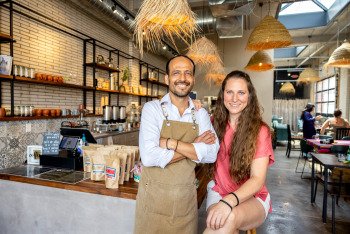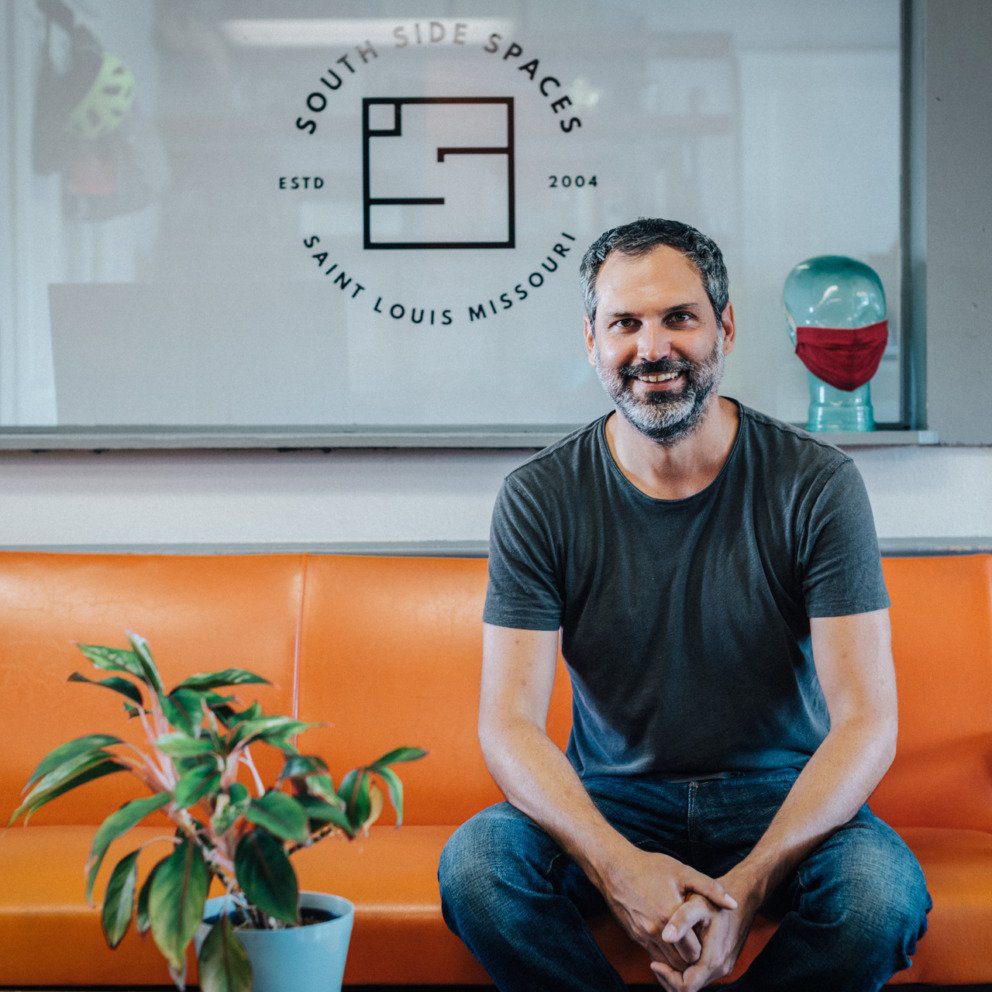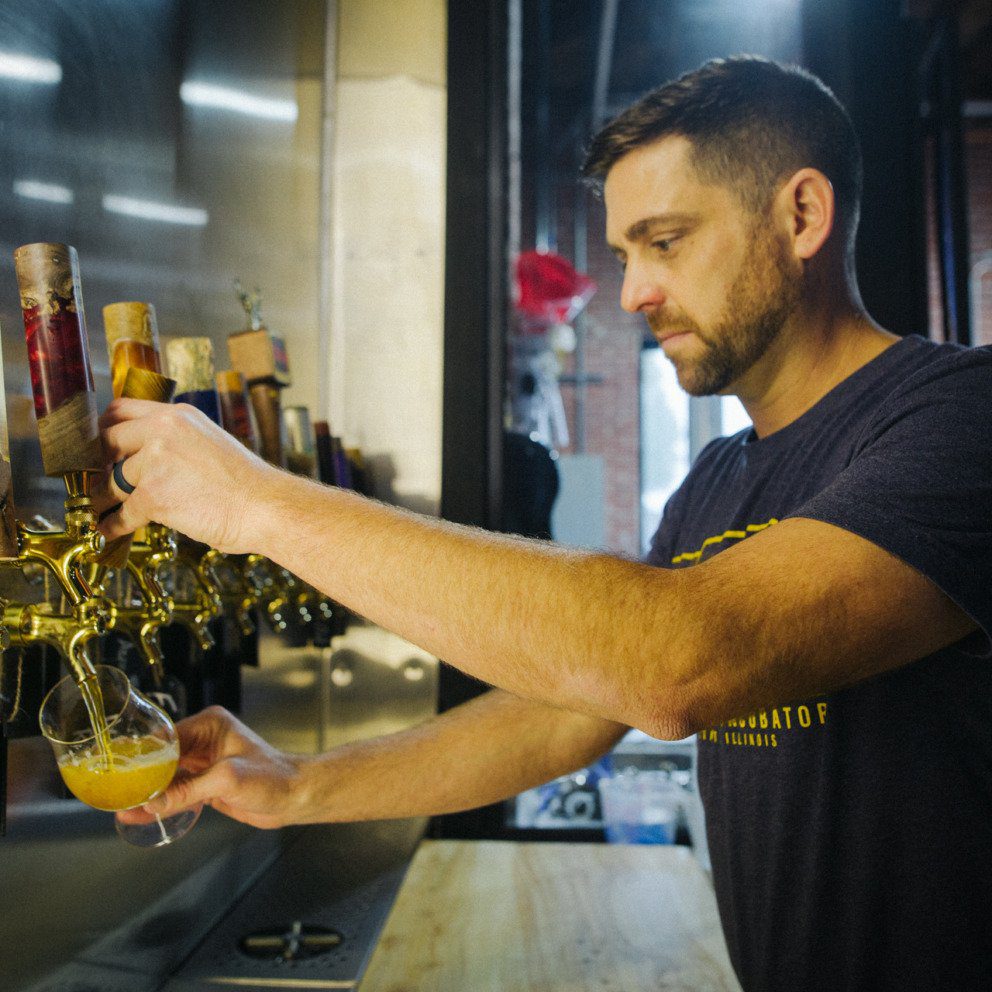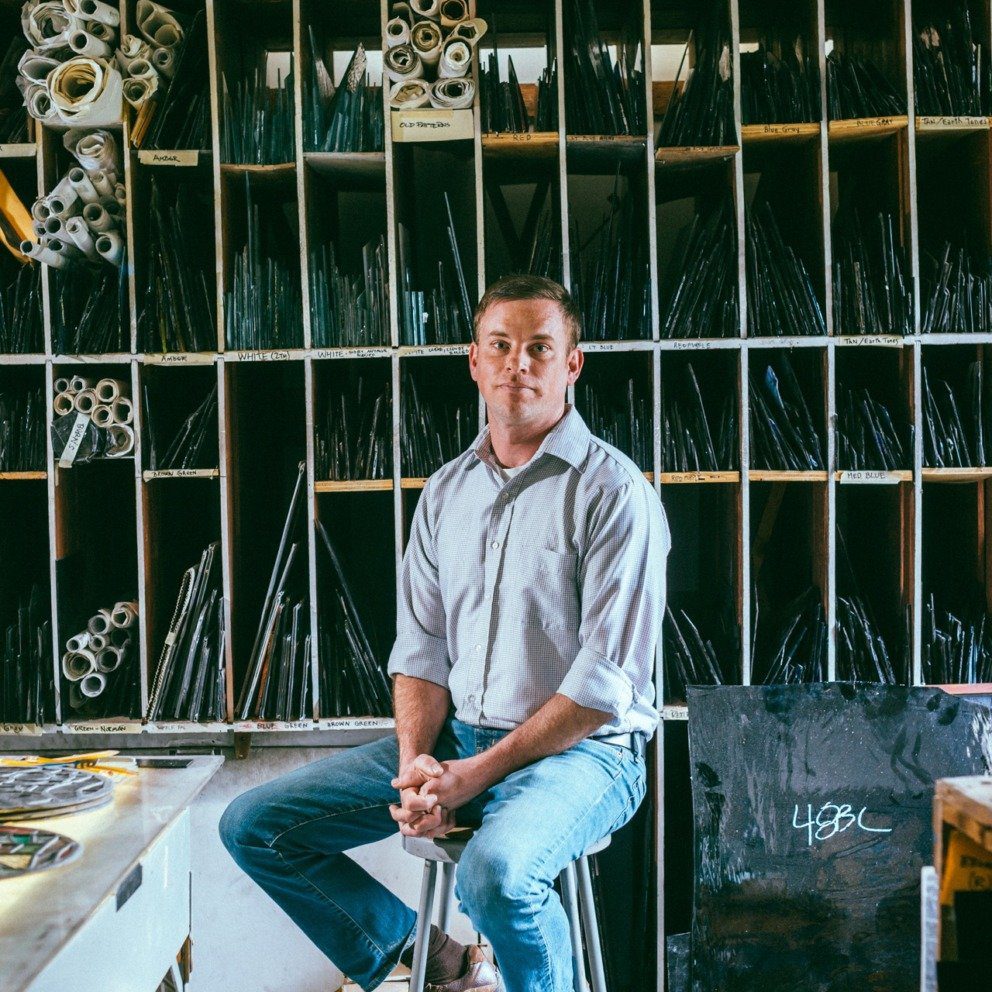Turning the Tables
David Stine crafts one-of-a-kind wood furniture for restaurants and homes around the country, all made from fallen trees on his fourth-generation family farm in Dow, Illinois.
Handcrafted wood furniture is both sought-after and treasured for its unique qualities – the beauty of the grain, the story it tells, the hours of work and attention to detail put into creating something that is built to last. For woodworker David Stine, the connection goes even deeper to the land itself, to the farm in Dow, Illinois, where he was born and raised. There, he sustainably harvests the hardwood timber he uses to make one-of-a-kind custom tables, benches, beds, bar tops and more. The furniture he makes can be spotted in some of the finest restaurants, businesses and homes in the St. Louis metro, and throughout the U.S.
“My inspiration for my designs mostly comes from the natural beauty of the wood and the forest,” Stine says. “Rather than constantly trying to impose my will on wood, I really have come to prefer letting the wood tell me what it wants to be.”
Stine hadn’t planned on becoming a full-time furniture maker, or being the fourth generation of his family to live and work on that land, once a working dairy farm run by his grandfather and uncles. Growing up, Stine, along with the rest of his family, did regular chores on the farm from chopping wood to milking cows, but he had little interest in being a dairy farmer for the rest of his life. What he did fall in love with was woodworking.
“We did a little bit of foresting and harvesting of trees in the wintertime, and I really gravitated towards that style of living and that kind of work,” he says.
His father and grandfather taught him how to work with the wood they harvested – using it to mend fences and build furniture, creating useful things with his own hands and igniting a lifelong passion
in him.
The oldest of his generation, his grandfather encouraged him to go to college and learn about tax law – another skill that could be helpful in managing and protecting the farm someday. So that’s precisely what he did, leaving the farm to attend Penn State, and eventually moving to Washington, D.C. to attend George Washington University School of Law, all the while continuing to practice woodworking. When he was still a student, he started Stine Woodworking as a side business, with tools and lumber from the family farm.
It was in D.C. where Stine met his wife, Stephanie Abbajay, at the bar that she and her sister had opened. Soon, they were married, and Stine graduated and passed the bar exam. He chipped away practicing law as a trust and estates attorney, but was unfulfilled with office life and continued to find solace in his wood shop at night and on the weekends. Abbajay was thriving running the bar as well as a nightclub and farm-to-table restaurant they started together, but she could tell her husband was deeply unhappy in his job – his true passion was calling him.
“She was the driving force saying, ‘if you’re not happy, you need to do something different,'” Stine says. “She gave me the courage just to go out on my own.”
At the time, he had a six-month waiting list of potential furniture customers on the back burner. He walked away from his career as an attorney to devote himself to woodworking full time and never looked back.
Stine made regular trips back to the farm to harvest native hardwoods and bring them back to his shop in D.C. As his client roster grew, he outgrew the space. In 2002, he and Abbajay packed up and moved back to the land where he was raised to be closer to family and dedicate himself to growing his business and starting a new life. Abbajay serves as David Stine Furniture’s managing director, helping to run and promote the business.
“Full circle, I ended up back here on the farm, but not milking cows,” he says.
“Sustainability is a big part of our ethos here. I grew up that way, my grandfather and all of our uncles and my parents always beat into our head, ‘take what you need from the land and leave the rest for the next guy,’ so we’ve always tried to live that way,” says Stine. “We steward the forest and we take dead and dying trees and then we mill them up and they go through the kiln process, and then we try to build furniture that people want to buy.”
Stine’s sustainability mindset extends to replanting, too.
“We don’t replant trees to just get the trees that we want,” he says. “What we do is we let the trees that want to grow there, grow and make it easy for them. So if the squirrels plant walnuts in this spot and walnuts grow, that’s probably where walnuts are supposed to grow – rather than over-managing the forest and trying to grow it like a crop and get just the things we want. And then that way it’s a great habitat for wildlife as well.”
The more Stine built, the more he drifted away from creating other people’s designs and focused more on designing his own pieces that celebrated the different varieties of wood available on the farm, including all varieties of oak, walnut, maple, pine, basswood and sycamore.
“Here in the Midwest, we’ve got really good soil and really good rain, especially here in the Mississippi Valley where the Illinois and Mississippi Rivers come together,” says Stine.
“We really do have some of the best lumber available in the world right here.”
Stine specializes in live-edge work, which he was first exposed to at the sawmill as a kid. When boards came off the sawmill, the first rough and irregular pieces were put off to the side. He would pull those boards off and keep them for little projects. Later, he researched and learned more about other renowned woodworkers who perfected the live-edge process like George Nakashima.
“I do all kinds of work, but live-edge is still really where my heart is,” he says.
His business model is simple and vertically integrated – Stine controls every step of the process from harvesting the wood to delivery of the final product. He provides his three employees with a living wage and a positive working environment, and they treat both the land and their customers with tremendous respect.
“I like meeting the clients and doing a quick education component about what is possible, what you can do with natural wood, what different woods are here in the Midwest and why we’re so lucky to be here in this area,” says Stine. “I like the fact that the furniture that we build here with integrity is going to be around for a long time.”
Sometimes the wood he uses to build is just a couple of years old, but sometimes it’s already been around for a long time.
“We just used some cherry wood in a project that I harvested when I was 15 years old and now I just turned 50,” says Stine. “So once the wood is dry and you store it properly, it’s just sitting there waiting for the right client to come around. It could be anywhere from 35 years to two years from the forest to the final product.”
Over more than 20 years, Stine’s business has grown to include clients around the world. His work has been featured at furniture shows across the U.S. including the Architectural Digest Show, where he was awarded “Best in Show, Sustainable Design” by the American Society of Interior Designers New York. Around 10 years ago, he caught the eye of celebrated St. Louis chef Gerard Craft, and a lasting partnership was born.
Craft was in the process of relocating his flagship restaurant, Niche, to Clayton and creating a concept in which everything in the restaurant would be locally sourced. He approached Stine about building some tables from locally harvested wood.
“When I first met Gerard, I could tell immediately that he was super psyched about his own artistry and his own work,” Stine says. “Working with a person like that is amazing.”
Stine would go on to design tables and bar tops for most of Niche Food Group‘s restaurants. Through his relationship with Craft, he was introduced to the larger St. Louis restaurant community, where he found a great deal of common ground and an easy rapport with some of the area’s top restaurateurs.
“I think the really great thing about the group of people I was introduced to in the restaurant community is that almost all of them are local people who are really trying to do something cool in St. Louis,” says Stine. “It’s a synergistic thing where we can all feed off each other. It’s really great.”
Those introductions led to collaborations with local favorites like Balkan Treat Box, Sidney Street Café, Peacemaker Lobster & Crab, Nudo House, The Tenderloin Room, Salt + Smoke, The Block, Elmwood and 58hundred.
Beyond the restaurant world, Stine has created furniture for numerous hotels, businesses and interior designers throughout St. Louis and across the country. He’s currently working on an exciting collaboration with the Missouri Botanical Garden. The architects building the new visitor’s center, Tao + Lee Associates, contacted Stine last year about removing and repurposing a large Shumard Oak tree that was in the middle of the construction site and believed to have been planted by Henry Shaw himself.
“They really wanted to celebrate that and do something with it,” Stine says. “So we got the tree harvested and cut down and then we brought it back here and it’s going to be a centerpiece of the new public food hall there. Basically, we’re going to make a bench out of it and leave it in almost perfect tree form, but with a scoop out for a bench area. I love the idea that they came to us to do something cool and it’s going to go right back in the Botanical Garden.”
Since moving back to the family farm in Illinois, Stine says his business has evolved from selling very little in St. Louis to now selling about 50 percent of his work in the area.
“I only see things getting better here in St. Louis,” he says. “And I think that rising tide is just going to continue to lift all boats here. I just see the trend going up and up.”
Join the Story
- Learn more on David Stine Furniture’s website.
- Read our story on Aaron Frei and his siblings, who create hand-crafted stained glass.







